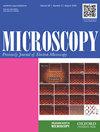Phase-shifting electron holography for accurate measurement of potential distributions in organic and inorganic semiconductors
IF 1.8
4区 工程技术
引用次数: 6
Abstract
Phase-shifting electron holography (PS-EH) is an interference transmission electron microscopy technique that accurately visualizes potential distributions in functional materials, such as semiconductors. In this paper, we briefly introduce the features of the PS-EH that overcome some of the issues facing the conventional EH based on Fourier transformation. Then, we present a high-precision PS-EH technique with multiple electron biprisms and a sample preparation technique using a cryo-focused-ion-beam, which are important techniques for the accurate phase measurement of semiconductors. We present several applications of PS-EH to demonstrate the potential in organic and inorganic semiconductors and then discuss the differences by comparing them with previous reports on the conventional EH. We show that in situ biasing PS-EH was able to observe not only electric potential distribution but also electric field and charge density at a GaAs p–n junction and clarify how local band structures, depletion layer widths and space charges changed depending on the biasing conditions. Moreover, the PS-EH clearly visualized the local potential distributions of two-dimensional electron gas layers formed at AlGaN/GaN interfaces with different Al compositions. We also report the results of our PS-EH application for organic electroluminescence multilayers and point out the significant potential changes in the layers. The proposed PS-EH enables more precise phase measurement compared to the conventional EH, and our findings introduced in this paper will contribute to the future research and development of high-performance semiconductor materials and devices.精确测量有机和无机半导体电势分布的相移电子全息术
相移电子全息术(PS-EH)是一种干涉透射电子显微镜技术,可以准确地观察半导体等功能材料中的电势分布。在本文中,我们简要介绍了PS-EH的特点,它克服了传统的基于傅立叶变换的EH所面临的一些问题。然后,我们提出了一种具有多电子双棱镜的高精度PS-EH技术和一种使用低温聚焦离子束的样品制备技术,这是精确测量半导体相位的重要技术。我们介绍了PS-EH的几种应用,以证明其在有机和无机半导体中的潜力,然后通过将其与以前关于传统EH的报告进行比较来讨论其差异。我们表明,原位偏置PS-EH不仅能够观察到电势分布,还能够观察到GaAs p–n结处的电场和电荷密度,并阐明了局部能带结构、耗尽层宽度和空间电荷如何根据偏置条件而变化。此外,PS-EH清楚地显示了在具有不同Al成分的AlGaN/GaN界面上形成的二维电子气层的局部电势分布。我们还报告了PS-EH在有机电致发光多层膜中的应用结果,并指出了层中的显著潜在变化。与传统EH相比,所提出的PS-EH能够实现更精确的相位测量,我们在本文中介绍的发现将有助于未来高性能半导体材料和器件的研发。
本文章由计算机程序翻译,如有差异,请以英文原文为准。
求助全文
约1分钟内获得全文
求助全文
来源期刊

Microscopy
工程技术-显微镜技术
自引率
11.10%
发文量
0
审稿时长
>12 weeks
期刊介绍:
Microscopy, previously Journal of Electron Microscopy, promotes research combined with any type of microscopy techniques, applied in life and material sciences. Microscopy is the official journal of the Japanese Society of Microscopy.
 求助内容:
求助内容: 应助结果提醒方式:
应助结果提醒方式:


